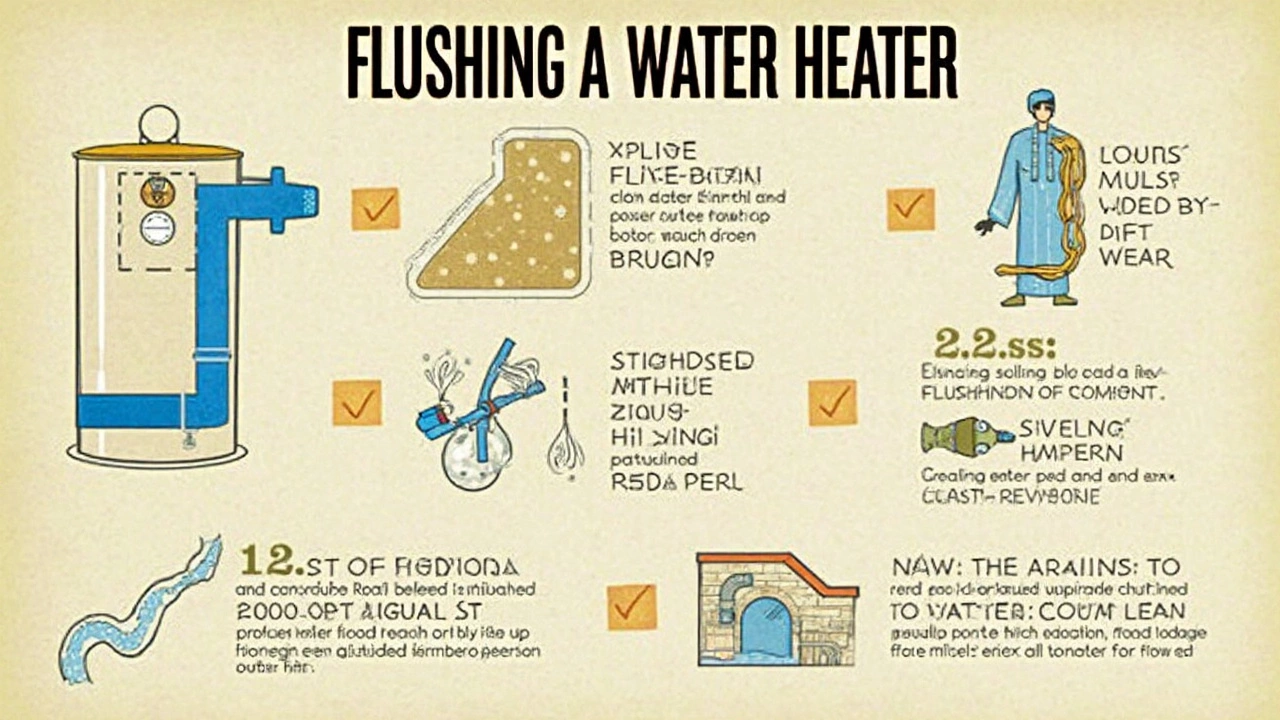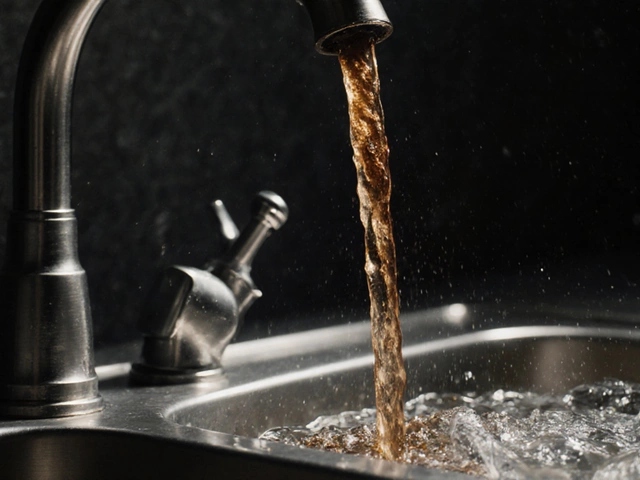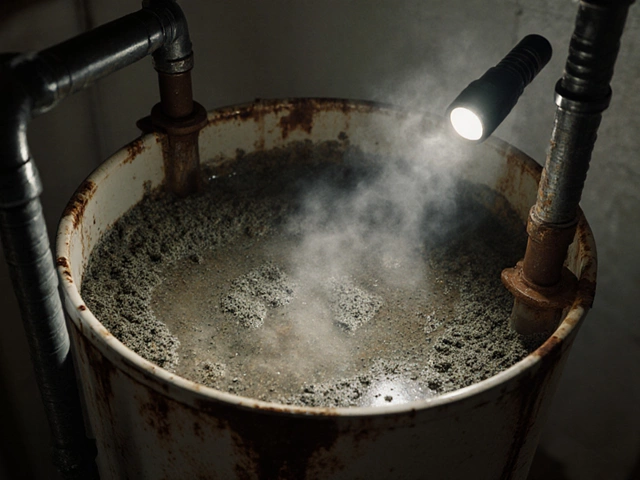So, you've got this water heater that's a decade old sitting in your garage or basement, just humming away. Ever wondered if you should give it a little maintenance love? More specifically, should you flush that bad boy? Well, here's the scoop: flushing your water heater is like giving it a well-deserved spa day. It's not just about keeping things neat and tidy; it's about making sure it works like a charm for as long as possible.
Now, you might think, 'What’s the big deal with flushing a water heater?' Well, it’s a pretty big deal! Over time, minerals like calcium or limestone build up at the bottom of your tank. This buildup isn’t just a mild annoyance; it could actually mess with your heater's efficiency and lifespan. So, when your heater’s efficiency drops, it’s not just cold showers you’re facing. It’s also higher energy bills. And who needs that?
- Why Flushing Matters
- Signs Your Water Heater Needs Flushing
- The Risks of Not Flushing
- How to Flush Your Heater
- When to Call a Professional
- Prolonging the Life of Your Water Heater
Why Flushing Matters
Alright, let’s talk about why you should bother with flushing your water heater. You know how your morning coffee machine gets clogged with mineral buildup if you don't clean it? Well, your water heater is pretty much the same, just on a larger scale. Over the years, minerals like calcium and lime sediment start stacking up inside. This is especially true if you live in an area with hard water, which most folks do.
Why care about this gunk? Simple. All that sediment reduces your heater's efficiency. Picture this: sediment acts as an insulator, making it harder for the heater to warm up the water. Your water heater has to work extra hard to heat the water, which means it uses more energy. You’re probably seeing dollar signs now, right? Higher energy usage equals higher bills.
But wait, there’s more to consider. Not flushing your heater can also lead to bigger problems like corrosion, which weakens the tank over time. Before you know it, you’re faced with leaks or total breakdowns. And replacing a old water heater isn’t cheap. In fact, a new unit can set you back anywhere from $500 to $1,500. Ouch! Flushing might seem like a hassle, but it’s one of those things where a little work now can save you a ton of stress—and cash—later.
There’s a good rule of thumb out there: flush your heater at least once a year. Doing this routinely helps prevent sediment overload and keeps your water heater maintenance on track. Remember, your water heater is one of the unsung heroes of your home, so why not give it the TLC it deserves?
Signs Your Water Heater Needs Flushing
Not sure if your water heater needs a flush? Trust me, there are some telltale signs that shouldn't be ignored. First off, if you've noticed that your hot water isn't as hot as it used to be, or it's running out faster than a caffeinated runner, it might be time to roll up your sleeves. These are classic signs your heater is struggling under the weight of mineral buildup.
Have you heard any strange moaning or knocking noises coming from your heater? Nope, it’s not haunted—it’s just sediment knocking around. This can happen when the minerals harden and create mini boulders at the bottom of your tank, causing performance hiccups.
Check the water coming out of your taps. If it’s looking rusty or cloudy, that’s a big red flag. It might mean something’s amiss inside your heater. Sediment build-up can lead to this discoloration, and it’s not the best ingredient for a nice, hot shower.
Here’s another sign you shouldn't ignore: spikes in your energy bills. When a heater works harder (because of all that gunk inside), it needs more energy, leading to higher bills. So, if you’ve noticed an uptick on your statements, your heater might be silently begging for a flush.
- Your hot water is lukewarm or runs out quickly.
- You hear odd noises from the heater.
- The water is rusty or cloudy.
- Unexplained increases in your energy bills.
Don’t ignore these signs. Your water heater's doing its best, but sometimes it just needs a little help from you to get back on track!
The Risks of Not Flushing
Neglecting to flush your water heater can lead to some pretty gnarly problems. Imagine minerals like calcium and lime creating a rock concert inside your tank. Over time, these deposits build up and steal away the space that water should occupy. It's kind of like hoarding but inside your water heater.
Letting these minerals hang around means your heater has to work extra hard just to do its job. This stress on the system can lead to overheating, and in some cases, can cause the heater to fail entirely. Nobody wants to wake up to a flooded basement or garage, right? The chances are, replacing an entire heater just because it became a sauna for a bunch of calcium rocks can be way more expensive than basic upkeep.
Another issue is the noise. Who wants a water heater that's louder than your neighbor's rock band practice? Those clanking and banging sounds are the minerals dancing around at the bottom of your tank. Not exactly the soundtrack anyone's hoping for.
"Regular maintenance, including flushing, is crucial for preventing sediment problems and extending the lifespan of your water heater," says Stacy Williams, a well-known plumbing expert.
And get this: sediment can insulate the water from the burner, meaning it uses more energy to heat the same amount of water. That might not sound like much, but over time, those extra dollars add up on your energy bill. And don't even get started on the potential risks for leaks or, if things get really extreme, causing the tank to burst. Wouldn't it be better to prevent these headaches with a little maintenance?
So, why let it get to that point when a flush can keep everything running smoothly? Regular flushing not only saves your heater but also your wallet. Give it a try, and you'll likely see a difference in performance and peace of mind.

How to Flush Your Heater
Flushing a water heater might sound daunting, but with a little patience and some elbow grease, it's a pretty straightforward task. It's like giving your heater a nice, refreshing drink, washing away all that crud that builds up over the years.
Before you get started, you'll need a few things: a garden hose, a bucket, and some time. It's not a race, so take your time to do it right.
- Turn off the Power and Water: First things first, turn off the power to your water heater. For electric heaters, switch off the breaker. If you have a gas heater, set it to 'pilot'. Next up, turn off the cold water supply at the top of the tank.
- Connect the Hose: Hook up a standard garden hose to the drain valve at the bottom of the heater. Run the other end to a nearby drain or out to your garden if it's safe and legal to do so.
- Open the Valve: Pop the pressure relief valve open to let air in as the water drains out. Then, twist open the drain valve. Let all that gunky water flow out until it runs clear. It might take a few minutes, so hang tight.
- Rinse and Repeat: Once the tank is empty, briefly turn the cold water supply on to push out any remaining sediment. Let it drain out completely.
- Close and Refill: Close the drain valve, remove the hose, and shut the pressure relief valve. Then, turn the water supply back on and let the tank fill. Once full, turn the power back on, and voilà! You're done.
See? Not too shabby, right? By flushing your heater regularly, you're not only avoiding sudden breakdowns but also boosting its efficiency. It's a win-win. Plus, you might just become the go-to person in your family for all things water heater repair!
When to Call a Professional
Sometimes, no matter how brave or handy you feel, it's best to call in the pros when it comes to your water heater repair. Not every job is a fair DIY match, especially with an older heater that's seen a few calendars come and go. So, how do you know when it's time to reach for the phone instead of the wrench?
If your water heater has sprung a leak, it's pretty much a blinking neon sign to get professional help. Leaks can lead to water damage, which is a whole other headache you don't want. Sure, tightening a loose valve might be in your skill set, but diagnosing the true cause of a leak isn't that straightforward. A pro will have the know-how to tackle this without turning your home into a paddling pool.
Another scenario that screams for expert intervention is when you notice strange, loud noises coming from your heater. Think banging, clanging, or any noise that could wake the neighbor's dog. These sounds often mean there's a significant mineral buildup or even a more serious mechanical issue you might not be equipped to handle.
Let's not forget about those mysterious fluctuations in water temperature. If hot showers turn into surprise ice blasts, or your taps are playing their own version of hot-and-cold, it’s likely time to call someone who knows their way around a water heater circuit.
| Issue | When to Call a Pro |
|---|---|
| Leaks | Immediately |
| Noises | If loud or persistent |
| Temperature Fluctuations | If regular adjustments do not fix |
Sure, saving a few dollars by avoiding a service call is tempting, but it's usually worth getting a pro, especially when parts of your heater act like they've got a mind of their own. They know how to pinpoint the issue without the trial-and-error approach, and that means less downtime and avoiding a situation that'll have you rushing to look up even more repair tips.
Prolonging the Life of Your Water Heater
Thinking about how to keep your old water heater in good working condition? You’re not alone! A ten-year-old water heater can still run plenty fine with a little TLC, keeping things warm and bills down. So, here are some practical tips on extending the lifespan of your trusty appliance.
Regular Maintenance is key. Make sure to flush your water heater at least once a year. This keeps sediment from sneaking in and setting up camp at the bottom of your tank. It’s like giving your heater a fresh start, and it keeps it running smoothly.
Another hot tip? Check the anode rod every couple of years. What is that, you ask? It’s a metal rod inside your tank that helps prevent rusting. When it wears down, your tank can start to corrode. Replacing a worn-out anode rod is cheaper and easier than a new heater.
Temperature also plays a role. Did you know the optimal setting for your heater temperature is around 120 degrees Fahrenheit (about 49 degrees Celsius)? It’s hot enough for bathing and cleaning without risking scalding water or energy overuse.
- Insulation: Wrap your tank in a water heater blanket. This inexpensive trick keeps heat from escaping and prevents the tank from working extra hard, saving energy and money.
- Test Pressure Relief Valve: Do this periodically by lifting the lever and letting it snap back. Water should gush out; if it doesn’t, it might be time for a replacement.
- Look for Leaks and Rust: Check around your heater for any signs of leaks or rust. Catching these early can prevent major damage later.
If you're not comfortable tackling these on your own, don’t hesitate to reach out to a professional. Sometimes the peace of mind is worth the service charge.
And there you have it! With these easy actions, you can maximize your heater's performance and longevity. Remember, a little preventive care goes a long way in helping your water heater live its best life.





